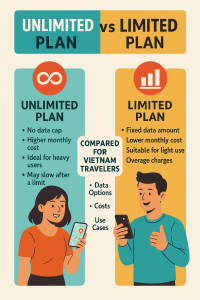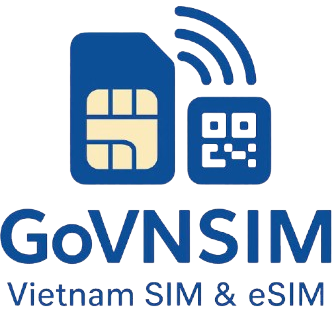No products in the cart.
Unlimited vs Limited Plans: Which One Truly Fits Your Travel Style?
Choosing between Unlimited vs Limited Plans is one of the most important decisions travelers and remote workers must make when planning mobile connectivity abroad. With the rise of eSIM technology and flexible mobile packages in countries like Vietnam, users now have more choices than ever. But more options can also create confusion. Should you pay for unlimited data and never worry about usage? Or save money with a limited plan that fits your minimal data needs? This article breaks down both options to help you decide.
Understanding Unlimited Plans
Unlimited plans are marketed as the ultimate freedom. For a fixed fee, you can use as much mobile data as you want throughout your plan period—no top-ups, no counting gigabytes. This appeals strongly to heavy users who rely on internet access for video streaming, online meetings, cloud uploads, and constant navigation via Google Maps or Grab.
However, the term “unlimited” is often misleading. Most telecom providers—including international eSIM vendors—apply what’s called a Fair Usage Policy (FUP). For example, after consuming 20GB or 50GB of data, your speed may be reduced drastically. Some providers throttle your connection from 4G to 2G speeds or deprioritize your data during network congestion. So, while usage is technically unlimited, performance may vary depending on your consumption.
When Unlimited Makes Sense
If you are:
- A digital nomad attending Zoom calls daily
- A traveler uploading videos to YouTube or social media regularly
- A long-term visitor using mobile data as your main connection
- A parent with kids streaming YouTube or Netflix on the go
…then an unlimited plan is likely your best bet. You can pay once, forget about topping up, and use your mobile internet however you like. Just be sure to check the fine print for speed throttling terms.
What Are Limited Data Plans?
On the other hand, limited plans come with a fixed data cap—such as 3GB, 5GB, 10GB, or 20GB—usually valid for a week, 15 days, or 30 days. They’re typically more affordable and ideal for travelers who only use mobile data occasionally. For example, if you only need internet for maps, messaging, checking email, and occasional browsing, a 5GB plan may last your entire trip.
One major advantage of limited plans is predictability. You know exactly how much data you have. There’s no risk of hitting a hidden speed limit like in some “unlimited” plans. Plus, topping up is often easy. With providers like GoVnSIM, you can add data in small amounts any time through their online system.
Cost Comparison: Unlimited vs Limited
Unlimited plans usually cost more—typically ranging from $15 to $35 for 15–30 days depending on the country and provider. Limited plans, by contrast, may cost as little as $5–$10 for a 5GB or 10GB package.
This raises a key point: why pay for unlimited if you only use 2–3GB per week? Budget travelers, short-stay tourists, and casual users often find limited plans to be more than enough—and much cheaper.
Use Case Example: Tourist in Vietnam
Let’s say you’re a tourist spending 10 days in Vietnam. You mostly use Wi-Fi in your hotel and cafes. You only need mobile data for ride-hailing apps (like Grab), Google Maps, and quick browsing. A 5GB limited eSIM plan would likely meet your needs perfectly, and you’d save at least 50% compared to a basic unlimited plan.
Which Plan Matches Your Lifestyle?
To summarize this first part:
- Unlimited Plans = Best for heavy data users, content creators, digital nomads, families
- Limited Plans = Best for short-term travelers, casual users, budget-conscious tourists
Still not sure? In Part 2, we’ll go deeper with a side-by-side comparison table, case studies from real GoVnSIM users, and specific plan suggestions based on your travel type.
Making the Right Choice: Unlimited vs Limited Plans
Choosing between Unlimited vs Limited Plans isn’t just about pricing—it’s about aligning the right data solution with your daily digital behavior, travel duration, and budget. In this second part, we’ll analyze practical use cases, breakdown the key decision points, and provide actionable tips to help you decide what’s best for your journey, whether you’re traveling through Vietnam or working remotely abroad.
When an Unlimited Plan is the Better Investment
Let’s say you’re working as a digital nomad or managing remote meetings on Microsoft Teams or Zoom while traveling. You can’t afford sudden drop-offs in data or worry about daily caps. An unlimited plan ensures continuous access to high-speed internet, reducing stress and enabling productivity. Even with fair usage policies, most unlimited eSIM plans throttle after very generous limits—such as 50GB—which is more than sufficient for all but the most intensive users.
Unlimited plans also make sense for content creators, YouTubers, and vloggers who regularly upload large files. Having consistent, fast access to cloud platforms like Dropbox or Google Drive can make or break a remote workflow. Additionally, parents with children may find peace of mind knowing their kids can stream content, download apps, and communicate with family without accidentally blowing through a small data cap.
Where Limited Plans Win
On the other hand, limited plans shine for those who use data with intention. If you’re a tourist visiting Vietnam for 5 to 10 days and primarily use hotel Wi-Fi, a 3GB or 5GB plan might be all you need. Apps like Google Maps, WhatsApp, Google Translate, and Grab are low-data tools that function perfectly on limited plans. And with GoVnSIM’s flexible top-up system, adding more data is seamless and affordable.
Moreover, limited plans can prevent unnecessary overuse. Many travelers use mobile data only during transit or when no Wi-Fi is available. For them, paying extra for unlimited data offers no practical advantage.
Use Case Comparison
- Backpackers & Students: Best with 5GB or 10GB plans, sufficient for social media, maps, and messaging.
- Digital Nomads: Prefer unlimited or high-capacity 30–50GB plans for work, cloud tools, and conferencing.
- Short-Term Business Trips: A balanced 10–20GB plan gives both value and room for flexibility.
- Families: Split between one unlimited plan (with hotspot) or multiple 5GB plans per member, depending on tech-savviness.
Planning for Data Use Abroad
To better decide between Unlimited vs Limited Plans, track your current data usage at home. Android and iOS devices allow you to view your average daily and monthly consumption. If you use 300–500MB daily, a 10GB plan may be sufficient for a 2-week trip. If your usage exceeds 2GB daily, unlimited is the safer choice.
Also, don’t forget offline strategies. Downloading maps, booking confirmations, and entertainment ahead of time can drastically cut data usage abroad—making a limited plan more viable.
Data from the Field: Real Users Speak
GoVnSIM surveyed 1,000 international travelers using eSIMs in Vietnam. 67% of short-stay tourists found 5GB was enough. However, 84% of long-term users (staying 30+ days) preferred unlimited or 50GB plans due to remote work and frequent travel across regions with inconsistent Wi-Fi. The data reinforces that lifestyle—not pricing alone—should drive your decision.
Conclusion: Don’t Buy More Than You Need
Ultimately, the debate of Unlimited vs Limited Plans boils down to one simple question: how much do you truly use? Don’t assume more is always better. Many travelers overpay for data they never consume. Evaluate your digital habits, consider your trip’s length and intensity, and choose a plan that supports—not exceeds—your lifestyle.
Visit GoVnSIM to explore both unlimited and limited eSIM options tailored for Vietnam travelers.

